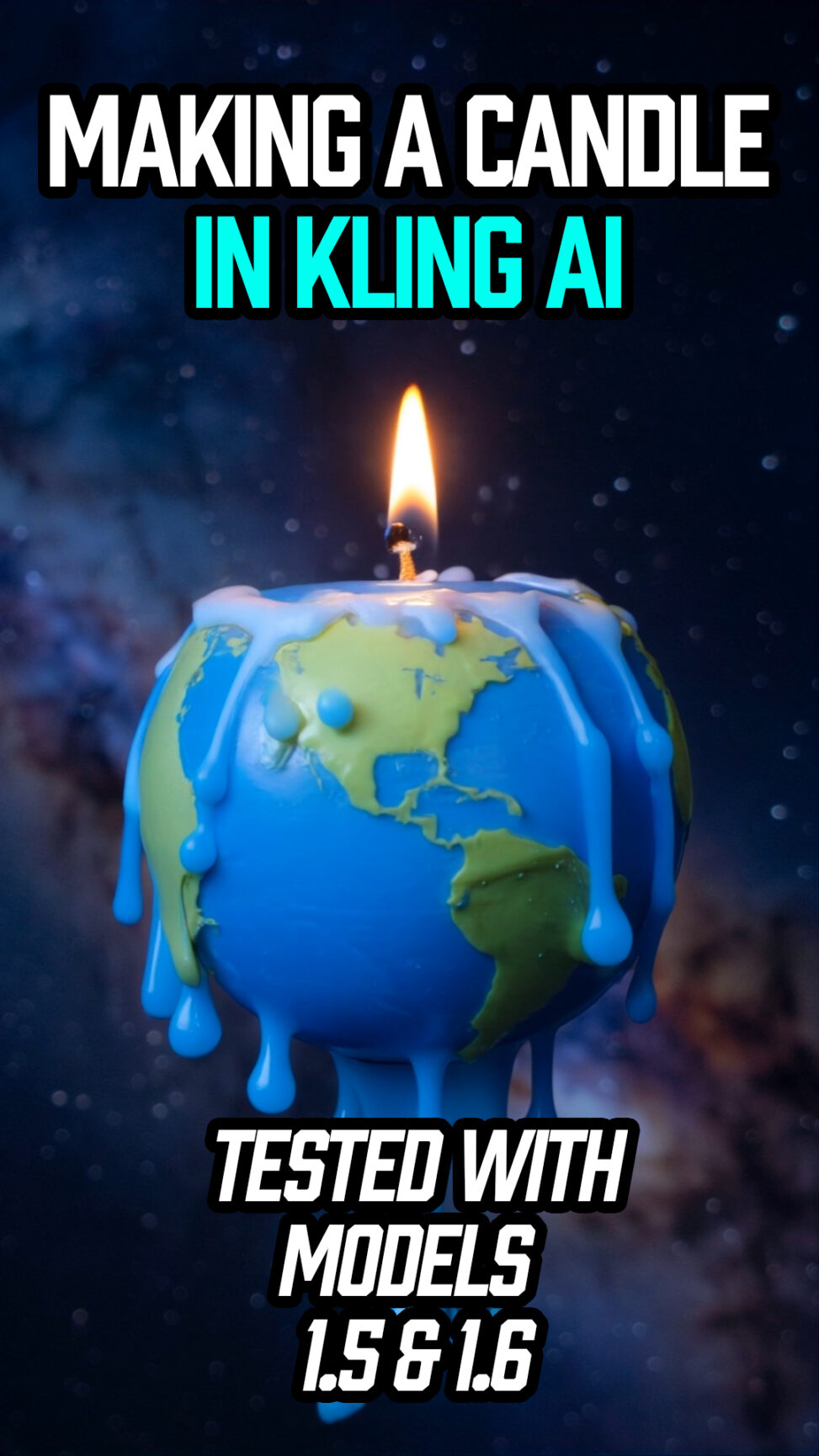Creating realistic AI-generated videos is an evolving challenge, and one of the biggest tests for any model is how well it can simulate real-world physics. To test this, I attempted to generate a time-lapse video of a globe-shaped candle melting naturally in Kling AI using Model 1.6 and Model 1.5.
After 19 different prompt variations, we came to a clear conclusion:
🔴 Model 1.6 does not understand how candles burn—wax behaves strangely, flames defy physics, and the candle often expands or moves in impossible ways.
🟢 Model 1.5 produces much better results, accurately showing wax dripping, the candle shrinking, and the wick burning properly.
The Experiment: Can AI Generate a Realistic Melting Candle?
The goal was to create a realistic time-lapse of a globe-shaped candle melting over time. The desired effect included:
✅ Wax dripping downward naturally (not floating, not flowing like liquid paint).
✅ A steady burn from the top down, with the candle gradually shrinking.
✅ A flame that stays attached to the wick (no floating or flying off).
✅ The wick burning down properly until the candle is gone.
Over multiple tests, I tried different prompts, tweaking wording, adding/removing negative prompts, and simplifying descriptions to see how AI interprets real-world physics. Here are the results.
All 19 Prompt Attempts: What Worked and What Failed?
🔴 Model 1.6: Repeated Failures
Despite careful prompt refinement, Model 1.6 produced highly unrealistic results.
Prompt 1:
📌 Time-lapse video of a globe-shaped candle extremely rapidly burning and melting and dripping wax of the globe into space.
✅ Good: Nice drips.
❌ Bad: The candle never shrank, and it didn’t go out. Given it was a 5-second clip, it should have burned halfway.
Prompt 2:
📌 Time-lapse video of a globe-shaped candle extremely fast rapidly burning and melting and dripping wax of the globe into space.
✅ Good: Thick drips.
❌ Bad: Instead of shrinking, the candle got bigger due to wax buildup.
Prompt 3:
📌 Time-lapse video of a globe-shaped candle extremely fast rapidly burning and melting and dripping wax of the globe into space, and the candle is becoming smaller and smaller.
✅ Good: Nothing notable.
❌ Bad: Wax flowed down incorrectly and pooled at the bottom.
Prompt 4:
📌 Time-lapse speed-up video of a globe-shaped candle extremely rapidly burning and melting and dripping wax of the globe into space.
✅ Good: Excellent drips.
❌ Bad: Candle did not shrink at all.
Prompt 5:
📌 Time-lapse speed-up video of a globe-shaped candle extremely rapidly burning, shrinking, melting, and dripping wax of the globe into space.
✅ Good: Decent drips.
❌ Bad: Candle never shrank.
Prompt 6:
📌 Time-lapse speed-up video of a globe-shaped candle extremely rapidly burning, shrinking, melting, and dripping wax of the globe into space, until the whole candle is melted and gone.
✅ Good: Nothing notable.
❌ Bad: Wax flowed down like a waterfall and then the wick started floating.
Prompt 7:
📌 Time-lapse speed-up video of a globe-shaped candle extremely rapidly burning, shrinking, melting, and dripping wax of the globe into space, until the whole candle is melted, the wick fully burned, and the whole object vanished.
✅ Good: A lot of dripping wax.
❌ Bad: Wax behaved like thick paint, rather than candle wax.
Prompt 8:
📌 Time-lapse speed-up video of a globe-shaped candle extremely rapidly burning, shrinking down, melting down, and dripping wax of the globe into space, until the whole candle is melted, the wick fully burned, and the whole object becomes smaller and smaller and vanishes.
✅ Good: Candle got smaller.
❌ Bad: Candle collapsed in an unnatural way, then faded instead of burning out.
Prompt 9:
📌 Time-lapse video of a spherical candle rapidly burning and melting. The wax drips off the globe into the vast emptiness of space, forming floating droplets.
✅ Good: Some drips.
❌ Bad: Flame floated away and the wick detached at the end.
Prompt 10:
📌 Time-lapse video of a spherical candle burning naturally from the top down.
✅ Good: The candle shrank correctly.
❌ Bad: Wax barely dripped, and at one point, random fire appeared in the bottom right corner.
Prompt 11-19:
🛑 Similar issues repeated across multiple variations:
- Wax dripping inconsistent or unrealistic.
- The candle not shrinking properly.
- The wick floating away or detaching.
- In one attempt, the candle suddenly launched upward like a rocket.
Final Verdict: Model 1.6 Simply Can’t Do Candles.
No matter how we changed the prompt, Model 1.6 fundamentally misunderstood how a candle burns.
🟢 Model 1.5: A Dramatic Improvement
When switching to Model 1.5, we immediately saw better results:
- The candle shrank correctly.
- The wick burned in a natural way.
- Drips were more realistic.
The Winning Prompt:
📌 Time-lapse video of a globe-shaped candle burning and melting from the top down in a natural and realistic manner. The flame consumes the wax, causing the upper part of the candle to collapse and deform over time. Thick wax drips downward, falling completely away into space. The wick shortens gradually and stays within the wax pool. The candle visibly decreases in size, with the upper layers melting first. Near the end, the last bit of wax is consumed, the wick burns out, and the flame flickers before fading into darkness.
✅ Best Results So Far!
The wax finally behaved properly, the candle melted realistically, and the wick burned out naturally. However, some issues remained:
- Drips could be thicker.
- The blackened wax at the end was slightly unnatural.
Still, Model 1.5 was far superior to Model 1.6 for this task.
Final Thoughts: Newer Doesn’t Always Mean Better
This experiment highlights a serious issue in AI development: newer models aren’t always better for every task.
🔴 Model 1.6 fails to simulate basic real-world physics and consistently misunderstood candle melting.
🟢 Model 1.5 performed far better, despite being an older model.
For anyone working with AI video generation, always test multiple models before assuming the latest version is the best.
Have you experienced similar issues with AI-generated physics? Share your thoughts below!


Leave a Reply
You must be logged in to post a comment.